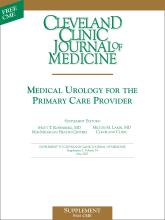ABSTRACT
Premature ejaculation (PE) is one of the most common sexual dysfunctions in men, with prevalence rates ranging from 21% to 31%. Because many physicians do not inquire about sexual dysfunction and patients are reluctant to offer it as a medical complaint, PE is underreported in clinical practice. A sexual history is therefore necessary to uncover the diagnosis. PE can have a significant impact on the quality of life of the patient and his sexual partner, and may lead to psychological distress and loss of self-esteem. It appears that PE has no single etiology, and treatments have been based on both its neurophysiologic and behavioral components. Although no therapies are currently approved for PE by the US Food and Drug Administration, medications that have shown some success include selective serotonin reuptake inhibitors, tricyclic antidepressants, phosphodiesterase type 5 inhibitors, and topical anesthetics. Behavioral techniques have been the mainstay of PE treatment, and include techniques to decrease sensory input.
Footnotes
↵* Milton M. Lakin, MD, has received consulting fees and honoraria from Pfizer and Eli Lilly/ICOS for consulting, teaching/speaking, and advisory board membership. He also reported having stock ownership interest in Pfizer and Eli Lilly.
↵** David R. Staskin, MD, has received honoraria from ESPRIT Pharma, Novartis, Pfizer, Ortho-McNeil, Watson Pharmaceuticals, and Astellas Pharma for teaching/speaking.
↵* Dr. Payne reported that he has received honoraria, consulting fees, and an educational grant from Eli Lilly/ICOS for teaching/speaking, consulting, and contracted research; honoraria and consulting fees from Sanofi-Aventis for teaching/speaking and advisory board membership; consulting fees from Boehringer Ingelheim for teaching/speaking and consulting; consulting fees from Pfizer, Johnson & Johnson, and Thomson Healthcare for consulting; and consulting fees from Reliant Pharmaceuticals for serving on an advisory committee. He also reported having an ownership interest in and receiving consulting fees from MedVantx. Dr. Sadovsky reported that he has no financial relationships that pose a potential conflict of interest with this article.
- Copyright © 2007 The Cleveland Clinic Foundation. All Rights Reserved.






